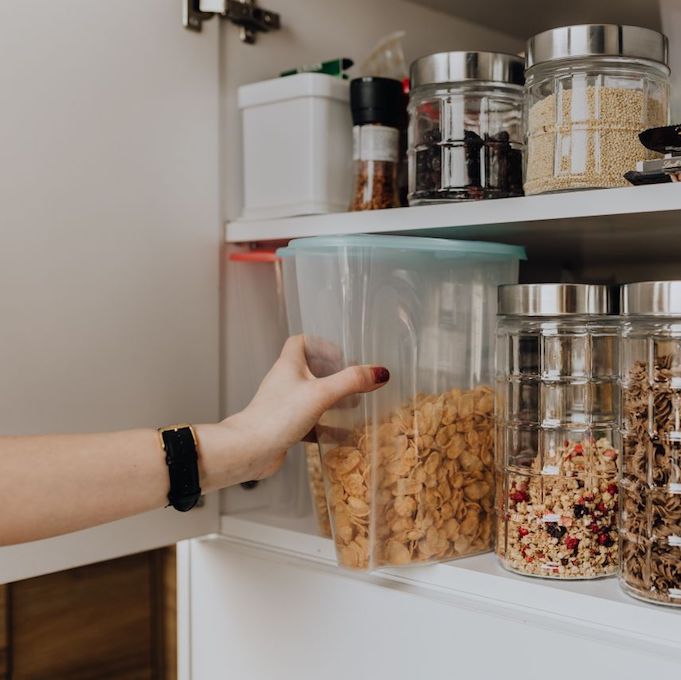
Do you regularly shop at big box or wholesale stores for home or work use?
Are you interested in keeping your home and office neat and organized after a shopping trip?
It’s no surprise big box stores offer unique discounts on bulk products.
While bulk product packaging makes in-store shopping a breeze, such packaging becomes an entirely different animal at home.
From large boxes, to shrink-wrap, to multipacks, dealing with bulk product packaging can be challenging, especially if you live in a small house or apartment.
The only question is, how can you seamlessly incorporate your big box purchases into your home and keep things organized?
In this post, you’ll find several tips to help you get organized after shopping at a big box store.
Simply follow these practical tips, and you’ll keep your living and work spaces neat and tidy.
Remove all purchases from your car.
You’ve just returned home from a fruitful shopping trip.
What’s your next step? Why, to bring your purchases inside your home, of course!
Sure, this might seem like a no-brainer, but it’s a critical point to keep in mind.
The longer you wait and/or leave things in your car, the less likely it is you’ll unpack your purchases in a timely fashion.
In fact, if you wait too long, you might misplace or forget items.
This could mean needlessly shopping and spending money on items you already have at home. Yikes!
So, do yourself a favor and bring all of your big box purchases from your car to the inside of your home as soon as possible.
Move items to their respective areas of the home ASAP.
Once you’ve got all big box purchases inside of your home, the next step is to move items to their respective areas of the home.
The idea here is to keep your living quarters clutter-free; you want to avoid cluttering up your hallway, doorways, living room, dining room, or kitchen as much as possible.
The process is easy: simply move items to where they will be used and/or stored.
For example, food products should be brought directly into the kitchen, bath products should be brought into the bathroom, office supplies should be brought into the home office, and so on.
If you’d like, you can make a list of which items should be brought into which room or areas of the home.
Downsize product packaging.
Big box packaging makes it easy to handle items when you’re shopping in-store.
But once you’re at home, this same packaging can be quite cumbersome.
Take a few moments to unwrap, remove, breakdown, and recycle bulky external packaging from your purchases.
You’ll have less clutter and packaging to deal with later on at home.
What are some ways you can downsize product packaging? For starters, you can:
- Remove plastic shrink-wrap, hooks, ties, wire, twine, and ribbon from packaging
- Extract items from heavy-duty plastic clamshell packaging
- Remove smaller items from medium and large-sized boxes
- Separate multipack containers, bottles, or boxes of product from one another
Rotate product stock.
Keep both food and non-food products fresh at home by rotating stock once you arrive home.
This ensures you’ll use up older product stored in your pantry or storage area.
Here’s an example of product rotation for you.
Let’s say you’ve just bought a case of 10 cans of green beans from a big box store.
You already have three cans of green beans at home.
In this case, you’d unwrap the 10 new cans of green beans and place them towards the back of the shelf, and then move the three existing cans of green beans towards the front of the shelf.
You can use this technique for a variety of items from foodstuffs, such as fresh, canned, jarred, and boxed goods.
You can do the same for health care items, such as vitamins, contact lens saline solution, and self-adhesive bandages, to beauty care items, such as makeup, lotions, and perfumes.
Don’t forget to do so for other household products such as batteries, lightbulbs, kitchen, and office supplies.
Transfer items to smaller containers.
Reduce the amount of unwieldy containers, packages, and boxes in your home by transferring items into smaller containers for everyday use.
This makes it easy to find what you need, instead of having to wade through a giant box, or container of items.
First, you’ll need to look through your home for plastic containers, glass jars, cardboard boxes, wooden crates, food storage containers, or any other organizational products that might be good candidates for storing small amounts of items.
Remember, you’re not trying to store every single item that came in the big box package; you want to store enough for you to use on a daily basis.
The next step is to remove a small handful or amount of items, and transfer this small amount into your designated daily storage container.
For example, if you bought a container of 5,000 count toothpicks, you’d simply remove a handful of toothpicks, and place this in a small container for use in the kitchen or dining room.
Here are several item transfer examples for you:
- Pens, pencils, or markers – remove a few writing implements, and place in your desk drawer, office pen cup, or other supply holder
- Paper plates and napkins – remove a small stack of each, and store on a shelf in a kitchen cupboard
- Granola bars – remove a small amount of individually wrapped granola bars and place in a medium-sized plastic container and store in pantry or on kitchen countertop
- Shampoo, conditioner, or lotion – decant a small amount of product into a small or medium-sized bottle or container for use in the shower or bath
- Batteries – remove a handful of batteries, and store in small container in a desk drawer, or cabinet
Create a big box storage space in your home.
Thus far, we’ve talked about bringing in items into your home, downsizing packaging, rotating stock, and transferring items into smaller containers.
The last step is to ensure you have storage space for excess items in your home.
Now, you can either do this in one of two ways.
If you’ve got a lot of space in your home, you can set up an all-purpose big box storage space.
Depending on the products you purchase, this could be a large pantry area, spare closet, garage, basement, or large spare refrigerator or freezer.
You’d organize and store the bulk of your big box purchases in these areas until they are ready to be transferring to a smaller container, or used outright.
You can stack items neatly on shelves or racks as necessary.
If you’re short on space in your home, you can carve out specific areas in rooms throughout the home to store large box items.
For example, if you purchased a giant bag of cotton balls, you’d remove a small amount and place in a small apothecary jar for your bathroom cabinet.
You’d then store the rest in an air-tight container under the bathroom sink or in a linen closet.
If you purchased a large box of brown sugar, you’d place a couple of cups into a smaller plastic container and store on the kitchen countertop, and would store the remainder of the sugar towards the back of a kitchen cabinet.
How about you? What part of big box product organization do you find to be the most challenging? Join the conversation and leave a comment below!





0 Comments